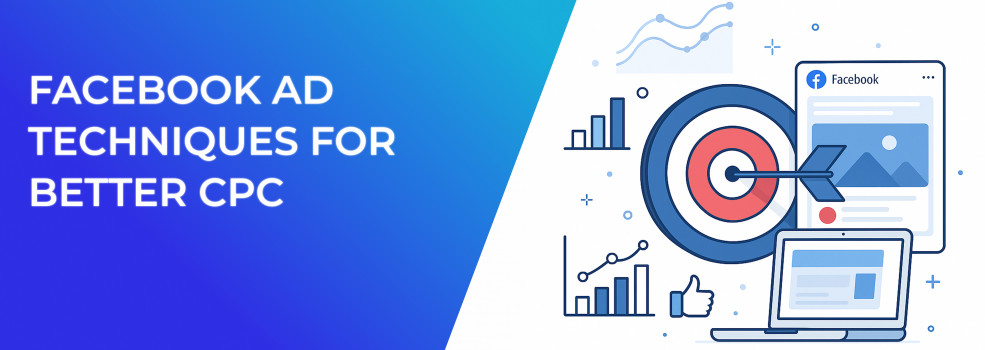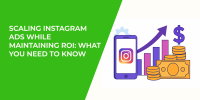Paying too much for each click on Facebook can feel like burning money. Industry data puts the average cost per click Facebook campaigns generate somewhere between $0.40 and $0.80, yet many advertisers watch their numbers creep past the one-dollar mark. The upside is that cost pressure is rarely permanent. With the right levers you can cut spend quickly while keeping conversions steady. The techniques below draw on hundreds of account audits and should help any team achieve good cost per click Facebook results within a single billing cycle.
1. Track the Only Three Metrics That Matter
Before touching budgets or creatives, build a single report that surfaces the core elements of Facebook ad performance.
-
Ad impressions Facebook shows how often your message reaches the people you actually want.
For a deeper dive into what an impression actually signifies and how to act when the count drops, read what Facebook ad impressions really mean. -
Average click through rate on Facebook ads reveals how well the message resonates.
-
CPC conversion rate ties spend to real revenue.
Track these three metrics first; everything else is noise.
If you want to push analysis further, this guide on analyzing Facebook ad performance beyond CTR and CPC lays out the next-level metrics worth tracking.
Reviewing this report every Monday forces you to spot leaks early. After each review, jot down one sentence explaining which metric is weakest and one experiment that could improve it. The habit keeps optimisation efforts focused instead of scattered.
Performance snapshots are helpful, but context matters just as much. Compare each week’s numbers with the previous four-week average so you can see whether a spike is just noise or a genuine trend.
2. Use Small, Intent-Based Audience Segments
Facebook rewards relevance. Rather than cramming five million people into one interest group, split the audience into clusters of 300,000 to 500,000 users built around clear intent signals. Beginners can start with the fundamentals in Facebook Ad Targeting 101: how to reach the right audience before drilling down to micro-segments.
For example, someone searching “Facebook Pixel WordPress” is at a very different stage of the funnel than someone reading about “e-commerce retargeting pixels.” By addressing each segment with copy that mirrors its exact pain point you typically lift CTR Facebook ads by 0.5 percentage points or more. Higher click-through almost always equals a cheaper auction bid and therefore lower CPC.
You can also test the layered approach outlined in interest stacking for Facebook audience segmentation to keep relevance scores high.
Once you have at least three healthy segments, turn on Advantage Campaign Budget or CBO Facebook ads so Meta can push budget toward whichever ad set is finding the best prices that hour.
3. Refresh Creatives Relentlessly
Visual fatigue is one of the fastest ways CPC drifts upward. A creeping CPC often signals creative burnout — this article on spotting ad fatigue early shows the red flags to watch for.
A simple weekly ads analysis will usually spot fatigue before your wallet feels it. Set up a testing calendar that cycles through the following creative elements:
Run each test for at least 72 hours to escape the learning phase, then roll the winning variation into your evergreen library. Finally, retire losing ads so they do not drag averages down.
Not sure which lever to pull first? What to test first — creative, copy or audience breaks down the decision.
Creatives need words as much as pictures. Keep headlines under 40 characters, echo the main benefit in the first line of body text, and align the Facebook ads landing page headline with the ad’s promise. Tight message match improves both CTR and conversion rate, compounding the CPC savings.
4. Let Campaign Budget Optimization Hunt for Bargains
Manual budget tweaks rarely react fast enough to the auction’s minute-by-minute swings. Switching to campaign budget optimization allows Meta to divert money toward the ad sets currently buying low-cost inventory. Pair CBO with a cost cap equal to roughly 80 percent of your target CPC to make sure the system never overpays when competition spikes. Leave the campaign running for a full week before judging results so the pacing algorithm can stabilise.
A quick health check at week’s end is simple: if average CPM Facebook costs have dropped but CTR stayed flat, CBO is doing its job. If CPM rises or CTR falls, revisit audience relevance and creative freshness first.
For a side-by-side look at budgeting methods, see daily budget vs CBO: which delivers better performance for local ads?
5. Set Up the Pixel Correctly and Retarget Warm Traffic
Poor data cripples optimisation. Take fifteen minutes to audit tracking:
-
Create Pixel on Facebook and verify events fire in the Event Tester.
-
Track at minimum view content, add to cart, and purchase.
-
Build audiences from your FB retargeting pixel for users who left before checkout.
Good data fuels cheap retargeting clicks—wire your pixel before spending another cent.
Anyone still wiring up their tracking can follow this step-by-step guide on setting up Facebook retargeting.
Once retargeting lists clear 2,000 people, launch campaigns that speak directly to abandoned-cart fears or offer a limited discount. Retargeted visitors often click at ten times the rate of cold traffic, turning once-expensive audiences into the cheapest clicks in your account.
Always set a frequency cap. Showing the same ad more than five times a week can erode goodwill and raise CPC when users start hiding your content. More detail on keeping exposure in check is covered in how frequency capping helps beat Facebook ad fatigue.
6. Combine High-Quality Lookalikes With Smart Exclusions
After logging one thousand conversions, create a 1 percent lookalike based on high-value buyers. A full comparison of the two audience types lives here: custom vs lookalike audiences—what works best?
At the same time, exclude recent purchasers and serial clickers who rarely convert. This dual move focuses impressions on users who resemble your best customers while removing traffic segments that inflate spend. Review exclusions once a month and adjust as new patterns emerge.
Lookalike performance is often best measured over a 14-day window. If CPC trends lower week over week and conversion rate holds steady, scale the audience by half-percentage increments until returns flatten.
7. Maintain a Weekly Feedback Loop
Optimisation is not a one-time lever; it is an ongoing loop. Each Monday:
-
Pause any ad set with CTR below 0.9 percent.
Speeding through the learning phase makes this weekly loop smoother — here’s how to finish the Facebook learning phase quickly. -
Increase budgets on winners by no more than 20 percent to avoid resetting learning.
-
Compare your metrics with industry average CTR for display ads solely as a reference; your trend line remains the definitive yardstick.
Close the session by writing down the single experiment you will run next. Consistent iteration keeps momentum alive and CPC moving in the right direction.
When CPC is under control and you’re ready to scale, study the science of scaling Facebook ads without killing performance for a roadmap.
Final Thoughts
Cutting CPC is less about secret hacks and more about disciplined structure. Track the right numbers, speak to tightly defined audiences, refresh creatives on a schedule, and let Facebook’s optimisation tools work for you. Follow these steps and you will soon see click costs drop while conversion totals hold strong.

